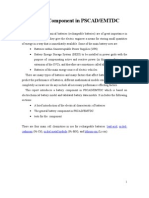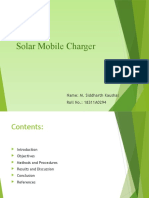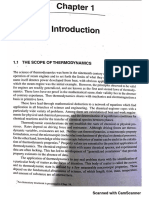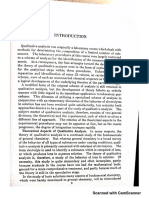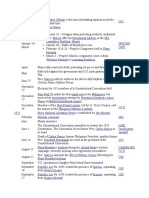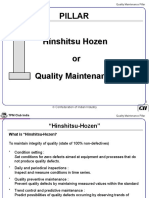0%(1)0% found this document useful (1 vote)
193 viewsLead-Acid Battery No. 1
Lead-Acid Battery No. 1
Uploaded by
Kuo Garol SarongThe lead acid battery uses lead and lead dioxide plates separated by an electrolyte of diluted sulfuric acid. During charging, lead dioxide is formed on the positive plate and lead is formed on the negative plate. During discharging, lead dioxide and lead sulfate react to release electrons through an external circuit. Chemical reactions reverse during recharging as electrons are supplied to reform lead dioxide and lead. The low-cost lead acid battery is well-suited for stationary applications where its high voltage and robust design are advantages.
Copyright:
© All Rights Reserved
Available Formats
Download as ODT, PDF, TXT or read online from Scribd
Lead-Acid Battery No. 1
Lead-Acid Battery No. 1
Uploaded by
Kuo Garol Sarong0%(1)0% found this document useful (1 vote)
193 views5 pagesThe lead acid battery uses lead and lead dioxide plates separated by an electrolyte of diluted sulfuric acid. During charging, lead dioxide is formed on the positive plate and lead is formed on the negative plate. During discharging, lead dioxide and lead sulfate react to release electrons through an external circuit. Chemical reactions reverse during recharging as electrons are supplied to reform lead dioxide and lead. The low-cost lead acid battery is well-suited for stationary applications where its high voltage and robust design are advantages.
Original Description:
Lead Battery
Copyright
© © All Rights Reserved
Available Formats
ODT, PDF, TXT or read online from Scribd
Share this document
Did you find this document useful?
Is this content inappropriate?
The lead acid battery uses lead and lead dioxide plates separated by an electrolyte of diluted sulfuric acid. During charging, lead dioxide is formed on the positive plate and lead is formed on the negative plate. During discharging, lead dioxide and lead sulfate react to release electrons through an external circuit. Chemical reactions reverse during recharging as electrons are supplied to reform lead dioxide and lead. The low-cost lead acid battery is well-suited for stationary applications where its high voltage and robust design are advantages.
Copyright:
© All Rights Reserved
Available Formats
Download as ODT, PDF, TXT or read online from Scribd
Download as odt, pdf, or txt
0%(1)0% found this document useful (1 vote)
193 views5 pagesLead-Acid Battery No. 1
Lead-Acid Battery No. 1
Uploaded by
Kuo Garol SarongThe lead acid battery uses lead and lead dioxide plates separated by an electrolyte of diluted sulfuric acid. During charging, lead dioxide is formed on the positive plate and lead is formed on the negative plate. During discharging, lead dioxide and lead sulfate react to release electrons through an external circuit. Chemical reactions reverse during recharging as electrons are supplied to reform lead dioxide and lead. The low-cost lead acid battery is well-suited for stationary applications where its high voltage and robust design are advantages.
Copyright:
© All Rights Reserved
Available Formats
Download as ODT, PDF, TXT or read online from Scribd
Download as odt, pdf, or txt
You are on page 1of 5
At a glance
Powered by AI
The key takeaways are that a lead acid battery uses lead and lead dioxide plates with a sulfuric acid electrolyte to convert chemical energy into electrical energy through reversible chemical reactions.
A lead acid battery works through reversible chemical reactions during charging and discharging. Hydrogen and sulfate ions move between the plates, reacting to change the composition of the plates and produce a flow of electrons through an external circuit.
The main components of a lead acid battery are the container, lead plates coated with active material (lead dioxide for the positive plate and sponge lead for the negative plate), separators between the plates, and sulfuric acid electrolyte.
Lead Acid Battery
Definition: The battery which uses sponge lead and lead peroxide for the conversion of the chemical
energy into electrical power, such type of battery is called a lead acid battery. The lead acid battery is
most commonly used in the power stations and substations because it has higher cell voltage and lower
cost.
Construction of Lead Acid Battery
The various parts of the lead acid battery are shown below. The container and the plates are the main
part of the lead acid battery. The container stores chemical energy which is converted into electrical
energy by the help of the plates.
1. Container – The container of the lead acid battery is made of glass, lead lined wood, ebonite, the
hard rubber of bituminous compound, ceramic materials or moulded plastics and are seated at the top to
avoid the discharge of electrolyte. At the bottom of the container, there are four ribs, on two of them
rest the positive plate and the others support the negative plates.
The prism serves as the support for the plates and at the same time protect them from a short-
circuit.The material of which the battery containers are made should be resistant to sulfuric acid, should
not deform or porous, or contain impurities which damage the electrolyte.
2. Plate – The plate of the lead-acid cell is of diverse design and they all consist some form of a grid
which is made up of lead and the active material. The grid is essential for conducting the electric
current and for distributing the current equally on the active material. If the current is not uniformly
distributed, then the active material will loosen and fall out.
The grids are made up of an alloy of lead and antimony. These
are usually made with the transverse rib that crosses the places at a right angle or diagonally. The grid
for the positive and negative plates are of the same design, but the grids for the negative plates are
made lighter because they are not as essential for the uniform conduction of the current.
The plates of the battery are of two types. They are the formed plates or plante plates and pasted or
faure plates.
Plante’s plates are used largely for stationary batteries as these are heavier in weight and more costly
than the pasted plates. But the plates are more durable and less liable to lose active material by rapid
charging and discharging. The plantes plate has low capacity weight-ratio.
Faure process is much suitable for manufacturing of negative plates rather than positive plates. The
negative active material is quite tough, and it undergoes a comparatively low change from charging and
discharging.
3. Active Material – The material in a cell which takes active participation in a chemical reaction
(absorption or evolution of electrical energy) during charging or discharging is called the active
material of the cell. The active elements of the lead acid are
1. Lead peroxide (PbO2) – It forms the positive active material. The PbO2 are dark chocolate
broom in colour.
2. Sponge lead – Its form the negative active material. It is grey in colour.
3. Dilute Sulfuric Acid (H2SO4) – It is used as an electrolyte. It contains 31% of sulfuric acid.
The lead peroxide and sponge lead, which form the negative and positive active materials have the little
mechanical strength and therefore can be used alone.
4. Separators – The separators are thin sheets of non-conducting material made up of chemically
treated leadwood, porous rubbers, or mats of glass fibre and are placed between the positive and
negative to insulate them from each other. Separators are grooved vertically on one side and are smooth
on the other side.
5. Battery Terminals – A battery has two terminals the positive and the negative. The positive terminal
with a diameter of 17.5 mm at the top is slightly larger than the negative terminal which is 16 mm in
diameter.
Working Principle of Lead Acid Battery
When the sulfuric acid dissolves, its molecules break up into positive hydrogen ions (2H+) and sulphate
negative ions (SO4—) and move freely. If the two electrodes are immersed in solutions and connected
to DC supply then the hydrogen ions being positively charged and moved towards the electrodes and
connected to the negative terminal of the supply. The SO4— ions being negatively charged moved
towards the electrodes connected to the positive terminal of the supply main (i.e., anode).
Each hydrogen ion takes one electron from the
cathode, and each sulphates ions takes the two negative ions from the anodes and react with water and
form sulfuric and hydrogen acid.
The oxygen, which produced from the above equation react with lead oxide and form lead peroxide
(PbO2.) Thus, during charging the lead cathode remain as lead, but lead anode gets converted into lead
peroxide, chocolate in colour.
If the DC source of supply is disconnected and if the voltmeter connects between the electrodes, it will
show the potential difference between them. If wire connects the electrodes, then current will flow from
the positive plate to the negative plate through external circuit i.e. the cell is capable of supplying
electrical energy.
Chemical Action During Discharging
When the cell is full discharge, then the anode is of lead peroxide (PbO2) and a cathode is of metallic
sponge lead (Pb). When the electrodes are connected through a resistance, the cell discharge and
electrons flow in a direction opposite to that during charging.
The hydrogen ions move to the anode and reaching the anodes receive one electron from the anode and
become hydrogen atom. The hydrogen atom comes in contacts with a PbO2, so it attacks and forms
lead sulphate (PbSO4), whitish in colour and water according to the chemical equation.
The each sulphate
—)
ion (SO4 moves towards the cathode and reaching there gives up two electrons becomes radical SO4,
attack the metallic lead cathode and form lead sulphate whitish in colour according to the chemical
equation.
Chemical Action During Recharging
For recharging, the anode and cathode are connected to the positive and the negative terminal of the
DC supply mains. The molecules of the sulfuric acid break up into ions of 2H+ and SO4—. The
hydrogen ions being positively charged moved towards the cathodes and receive two electrons from
there and form a hydrogen atom. The hydrogen atom reacts with lead sulphate cathode forming lead
and sulfuric acid according to the chemical equation.
SO4—
ion moves to the anode, gives up its two additional electrons becomes radical SO4, react with the lead
sulphate anode and form leads peroxide and lead sulphuric acid according to the chemical equation.
The charging and discharging are represented by a single
reversible equation given below.
The equation should read downward for
discharge and upward for recharge.
https://circuitglobe.com/lead-acid-battery.html
https://www.scribd.com/document/238220651/Fluid-Mechanics-Reviewer
You might also like
- A Mathematical Model For Lead-Acid BatteriesDocument6 pagesA Mathematical Model For Lead-Acid BatteriesBalasubramanian ANo ratings yet
- Electric Circuits Clo ZeDocument1 pageElectric Circuits Clo ZeSole GutiérrezNo ratings yet
- Final Exam Grad 2020Document2 pagesFinal Exam Grad 2020NicoleNo ratings yet
- Zakhara Adventurer's Guide - TOCDocument3 pagesZakhara Adventurer's Guide - TOCNeill Henderson0% (2)
- Battery WorkingDocument8 pagesBattery Workingankush belkarNo ratings yet
- Electrochemical CellDocument11 pagesElectrochemical CellssssNo ratings yet
- Smart Street Light System PDFDocument22 pagesSmart Street Light System PDFDevesh SrivastavaNo ratings yet
- Lead Acid BatteryDocument14 pagesLead Acid BatterydaabgchiNo ratings yet
- 1 BatteriesDocument27 pages1 BatteriesJason MaldonadoNo ratings yet
- Battery: Theory and PracticeDocument23 pagesBattery: Theory and PracticeAsmawi Mohd KhailaniNo ratings yet
- Battery Characteristics Part1Document8 pagesBattery Characteristics Part1JollyZooNo ratings yet
- Paper BatteryDocument16 pagesPaper BatteryshivamNo ratings yet
- Chemical Energy To Electrical Energy ConversionDocument37 pagesChemical Energy To Electrical Energy ConversionCrichelleMaeNo ratings yet
- PPTDocument32 pagesPPTsingh vipulNo ratings yet
- Electron TheoryDocument49 pagesElectron TheoryAndy Bong NavarroNo ratings yet
- Motors and Generators FunctionsDocument7 pagesMotors and Generators FunctionsSEAN GABRIEL JORDANNo ratings yet
- Advances in ZEBRA BatteriesDocument8 pagesAdvances in ZEBRA BatteriesEleftherios DeNo ratings yet
- Batteries and ChargersDocument129 pagesBatteries and ChargersAnonymous g0InJ4BLBNo ratings yet
- Introduction To Super CapacitorsDocument28 pagesIntroduction To Super CapacitorsLokesh EshwaraiahNo ratings yet
- Final of FinalDocument35 pagesFinal of FinalsamruithNo ratings yet
- L 11 - Battery Parameters Part 1Document16 pagesL 11 - Battery Parameters Part 1Dorababu Bandi100% (1)
- Cell & BatteriesDocument16 pagesCell & BatteriesMahnoor Aqeel100% (1)
- An Overview of Lithium-Ion Batteries For Electric VehiclesDocument6 pagesAn Overview of Lithium-Ion Batteries For Electric VehiclesMDRNo ratings yet
- Need For Alternate Energy SourcesDocument17 pagesNeed For Alternate Energy SourcesshruniviNo ratings yet
- Design and Simulation of 20 MVAR Three Phase Shunt Reactor For Voltage Suppression at 230 KV Transmission Line (Kyaukpyu Primary Substation)Document10 pagesDesign and Simulation of 20 MVAR Three Phase Shunt Reactor For Voltage Suppression at 230 KV Transmission Line (Kyaukpyu Primary Substation)umer100% (1)
- Nicad and Lead Acid BatteriesDocument2 pagesNicad and Lead Acid BatteriesSukalyan Ghoshal100% (1)
- Report of Battery ModelDocument13 pagesReport of Battery ModelvbvirulkarNo ratings yet
- FC Basics Technology TypesDocument2 pagesFC Basics Technology TypesRaja RJNo ratings yet
- Batteries & Fuel Cells-1Document33 pagesBatteries & Fuel Cells-1Abdo MohdyNo ratings yet
- Battery Charging UnitDocument19 pagesBattery Charging UnitAbinMiranda100% (1)
- A Review of Integrated On-Board EV BatteryDocument27 pagesA Review of Integrated On-Board EV Batterymohamed yehiaNo ratings yet
- Types of BatteriesDocument37 pagesTypes of BatteriesvendralokeshNo ratings yet
- Mandal - Power Electronics-MC GRAW HILL INDIA (2014)Document891 pagesMandal - Power Electronics-MC GRAW HILL INDIA (2014)Meral MeralNo ratings yet
- BatteriesDocument23 pagesBatteriesapi-370156767% (3)
- Comparison of I C Logic FamiliesDocument2 pagesComparison of I C Logic FamiliesVinod kumarNo ratings yet
- 5S ProgramDocument15 pages5S ProgramGaurav Kumar100% (4)
- Transformer: From Wikipedia, The Free EncyclopediaDocument23 pagesTransformer: From Wikipedia, The Free EncyclopediaArun Kumar ShahNo ratings yet
- Hoppecke ManualDocument61 pagesHoppecke ManualIvaylo IvanovNo ratings yet
- Recent Progress of Magnetic Field Application in Lithium Based BatteriesDocument19 pagesRecent Progress of Magnetic Field Application in Lithium Based BatteriesKiki Rezki LestariNo ratings yet
- 23.solar EnergyDocument7 pages23.solar EnergymariyaNo ratings yet
- Module 6 and 7 Batteries PDFDocument89 pagesModule 6 and 7 Batteries PDFharshNo ratings yet
- Ola Al QasemDocument212 pagesOla Al QasemMadalina-Alexandra PuscasuNo ratings yet
- Pole PitchDocument4 pagesPole PitchAryan RajNo ratings yet
- Standby Plante140704Document59 pagesStandby Plante140704jayaNo ratings yet
- D7 Solar Panel DevicesDocument12 pagesD7 Solar Panel Devicesarunguptha_gs100% (1)
- Powerpoint Presentation On: Automatic Street Light Control Using LDRDocument19 pagesPowerpoint Presentation On: Automatic Street Light Control Using LDRvasu devaraoNo ratings yet
- Charging and Discharging Methods of LeadDocument24 pagesCharging and Discharging Methods of LeadShubham100% (1)
- Circuit BreakerDocument23 pagesCircuit BreakerCedrick100% (2)
- Storage Batteries - Batt Impedance CharacteresticsDocument6 pagesStorage Batteries - Batt Impedance CharacteresticscadtilNo ratings yet
- Lead Acid BatteryDocument4 pagesLead Acid BatterybrenofqNo ratings yet
- Nickel-Based Rechargeable BatteriesDocument24 pagesNickel-Based Rechargeable Batteriesmarcos_visNo ratings yet
- UNIT-2 Battery TechnologyDocument25 pagesUNIT-2 Battery TechnologyVasudev GuptaNo ratings yet
- Battery Safety 101 - Anatomy - PTC Vs PCB Vs CID - 18650 Battery - BATTERY BRODocument7 pagesBattery Safety 101 - Anatomy - PTC Vs PCB Vs CID - 18650 Battery - BATTERY BROAhmed IsaNo ratings yet
- 3-1 PPT Solar-Mobile-ChargerDocument16 pages3-1 PPT Solar-Mobile-Chargermanga siddharthNo ratings yet
- Basic TransformerDocument10 pagesBasic TransformerPin SantosNo ratings yet
- Exp 1: OC and SC Test Along With Direct Load Test On A Single Phase TransformerDocument7 pagesExp 1: OC and SC Test Along With Direct Load Test On A Single Phase TransformerSumit KatreNo ratings yet
- DSE3 Battery SRCDocument60 pagesDSE3 Battery SRCAashidha KmNo ratings yet
- What Is Lead Acid Battery: Types, Working & Its ApplicationsDocument5 pagesWhat Is Lead Acid Battery: Types, Working & Its ApplicationshjhjNo ratings yet
- Lead Acid BatteryDocument23 pagesLead Acid BatteryBrahmpal BhardwajNo ratings yet
- Ash's Lead Storage BatteryDocument16 pagesAsh's Lead Storage Batteryitsmeomtiwari04No ratings yet
- Ev Batteries BasicDocument66 pagesEv Batteries BasicmahammadsalmanmechNo ratings yet
- Bel NotesDocument7 pagesBel NotesUsama JanNo ratings yet
- Day 2Document2 pagesDay 2Kuo Garol SarongNo ratings yet
- DocxDocument3 pagesDocxKuo Garol SarongNo ratings yet
- 2Document6 pages2Kuo Garol Sarong100% (1)
- 1Document6 pages1Kuo Garol SarongNo ratings yet
- Day 3 PICHEDocument13 pagesDay 3 PICHEKuo Garol SarongNo ratings yet
- Intro To ThermoDocument1 pageIntro To ThermoKuo Garol SarongNo ratings yet
- Sample ProblemDocument1 pageSample ProblemKuo Garol SarongNo ratings yet
- Intro To Thermo 1Document1 pageIntro To Thermo 1Kuo Garol SarongNo ratings yet
- Entropy ChangeDocument1 pageEntropy ChangeKuo Garol SarongNo ratings yet
- DiffusionDocument1 pageDiffusionKuo Garol SarongNo ratings yet
- Scanned With CamscannerDocument1 pageScanned With CamscannerKuo Garol SarongNo ratings yet
- Vital Statistics - 20190720122838Document1 pageVital Statistics - 20190720122838Kuo Garol SarongNo ratings yet
- New Doc 2019-06-17 11.18.06 - 20190617111842Document1 pageNew Doc 2019-06-17 11.18.06 - 20190617111842Kuo Garol SarongNo ratings yet
- Mass Transfer - 20190902115750Document1 pageMass Transfer - 20190902115750Kuo Garol SarongNo ratings yet
- Statics 4Document1 pageStatics 4Kuo Garol SarongNo ratings yet
- Qualitative AnalysisDocument1 pageQualitative AnalysisKuo Garol SarongNo ratings yet
- Statics 5Document1 pageStatics 5Kuo Garol SarongNo ratings yet
- StaticsDocument1 pageStaticsKuo Garol SarongNo ratings yet
- EvaporationDocument1 pageEvaporationKuo Garol SarongNo ratings yet
- The Dark Side of The Moon Roe v. WadeDocument4 pagesThe Dark Side of The Moon Roe v. WadeKuo Garol SarongNo ratings yet
- Statics 3Document1 pageStatics 3Kuo Garol SarongNo ratings yet
- Process Flow For Used Up BatteryDocument1 pageProcess Flow For Used Up BatteryKuo Garol SarongNo ratings yet
- Civilian Home Defense ForcesDocument15 pagesCivilian Home Defense ForcesKuo Garol SarongNo ratings yet
- Statics 1Document1 pageStatics 1Kuo Garol SarongNo ratings yet
- Cory Conjuangco - Aquino (Agrarian Reform)Document3 pagesCory Conjuangco - Aquino (Agrarian Reform)Kuo Garol SarongNo ratings yet
- History 2Document13 pagesHistory 2Kuo Garol SarongNo ratings yet
- Lead-Acid Battery No. 2Document5 pagesLead-Acid Battery No. 2Kuo Garol SarongNo ratings yet
- Reification A Myth' Shock (Or What Gillian Rose Tells Us About Sohn-Rethel, Adorno and Ancient Greece)Document5 pagesReification A Myth' Shock (Or What Gillian Rose Tells Us About Sohn-Rethel, Adorno and Ancient Greece)Abbass BrahamNo ratings yet
- Specific TL ActivitiesDocument2 pagesSpecific TL ActivitiesTeresa Pajarón LacaveNo ratings yet
- Frequency Adverbs ExplanationDocument11 pagesFrequency Adverbs ExplanationEDGARDO DE JESUS BENITEZ MARTINEZNo ratings yet
- The People of The Philippines, Plaintiff-Appellee, vs. Freedie Lizada at Fredie LIZADA, Accused-AppellantDocument18 pagesThe People of The Philippines, Plaintiff-Appellee, vs. Freedie Lizada at Fredie LIZADA, Accused-AppellantFredamoraNo ratings yet
- Appeals OutlineDocument17 pagesAppeals OutlinecarinokatrinaNo ratings yet
- Expense StudyDocument21 pagesExpense StudyIotalaseria PutuNo ratings yet
- Chap 02 (Fluid Mechanic) PDFDocument65 pagesChap 02 (Fluid Mechanic) PDFK'roll Azham AvearNo ratings yet
- Ecotourism Activity - Bird WatchingDocument76 pagesEcotourism Activity - Bird WatchingCharles Erwin SuicoNo ratings yet
- Comparison: Adverbs (Worse, More Easily) : Adverbs: Comparative and Superlative FormsDocument9 pagesComparison: Adverbs (Worse, More Easily) : Adverbs: Comparative and Superlative FormsFABIAN FIENGONo ratings yet
- MedStudyCS Cards PulmDocument85 pagesMedStudyCS Cards Pulmdrimran570No ratings yet
- Cp154 Illegal Transactions ConsultationDocument188 pagesCp154 Illegal Transactions ConsultationjmalemanyNo ratings yet
- Side Effects of Common Drugs PDFDocument2 pagesSide Effects of Common Drugs PDFImran ChaudhryNo ratings yet
- Investiture Ceremony For BOY SCOUT SECTION LONGDocument3 pagesInvestiture Ceremony For BOY SCOUT SECTION LONGLørd Ken M. Dilao100% (1)
- Handout About Approaches in Teaching Literature - 024510Document2 pagesHandout About Approaches in Teaching Literature - 024510Rose Marie OderioNo ratings yet
- S SSP 2013 RossiterDocument9 pagesS SSP 2013 RossiterJoan MilenovNo ratings yet
- S. Practice CourtDocument3 pagesS. Practice CourtHarrison sajorNo ratings yet
- HEC GAT Sample PapersDocument321 pagesHEC GAT Sample PapersIbrahim Afganzai100% (2)
- Public International LawDocument21 pagesPublic International LawHemantVerma50% (2)
- Basic KannadaDocument15 pagesBasic Kannadaakarsh_nairNo ratings yet
- Selvi's Statement of Claim - Altantuya Murder CaseDocument26 pagesSelvi's Statement of Claim - Altantuya Murder CaseSweetCharity77No ratings yet
- Cheerag FormDocument1 pageCheerag FormAYUSHMAAN SAININo ratings yet
- Lecture 1 Notes - PHIL2661Document6 pagesLecture 1 Notes - PHIL2661Max MacdonaldNo ratings yet
- CHRIST AMBASSADORS STUDENTS' OUTREACH (Unilag Chapter A.K.A The Family of Love)Document2 pagesCHRIST AMBASSADORS STUDENTS' OUTREACH (Unilag Chapter A.K.A The Family of Love)chiemenaNo ratings yet
- D-Intervenors Motion For Complete Summary Judgement With ExhibitsDocument74 pagesD-Intervenors Motion For Complete Summary Judgement With Exhibitsapi-467534276No ratings yet
- SBM Process 1Document8 pagesSBM Process 1Judy Panguito Aralar100% (1)
- TPM QM TrainingDocument16 pagesTPM QM TrainingSunil100% (3)
- ALiEditor User ManualDocument15 pagesALiEditor User ManualjNo ratings yet
- 18 July KeyDocument1 page18 July KeyrajeshNo ratings yet


























